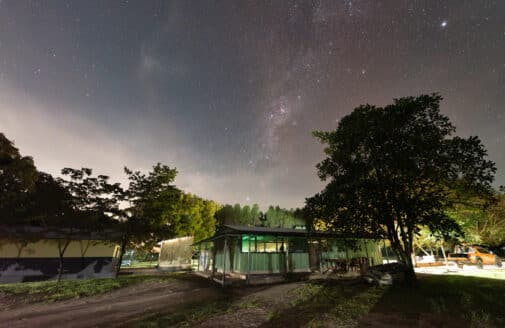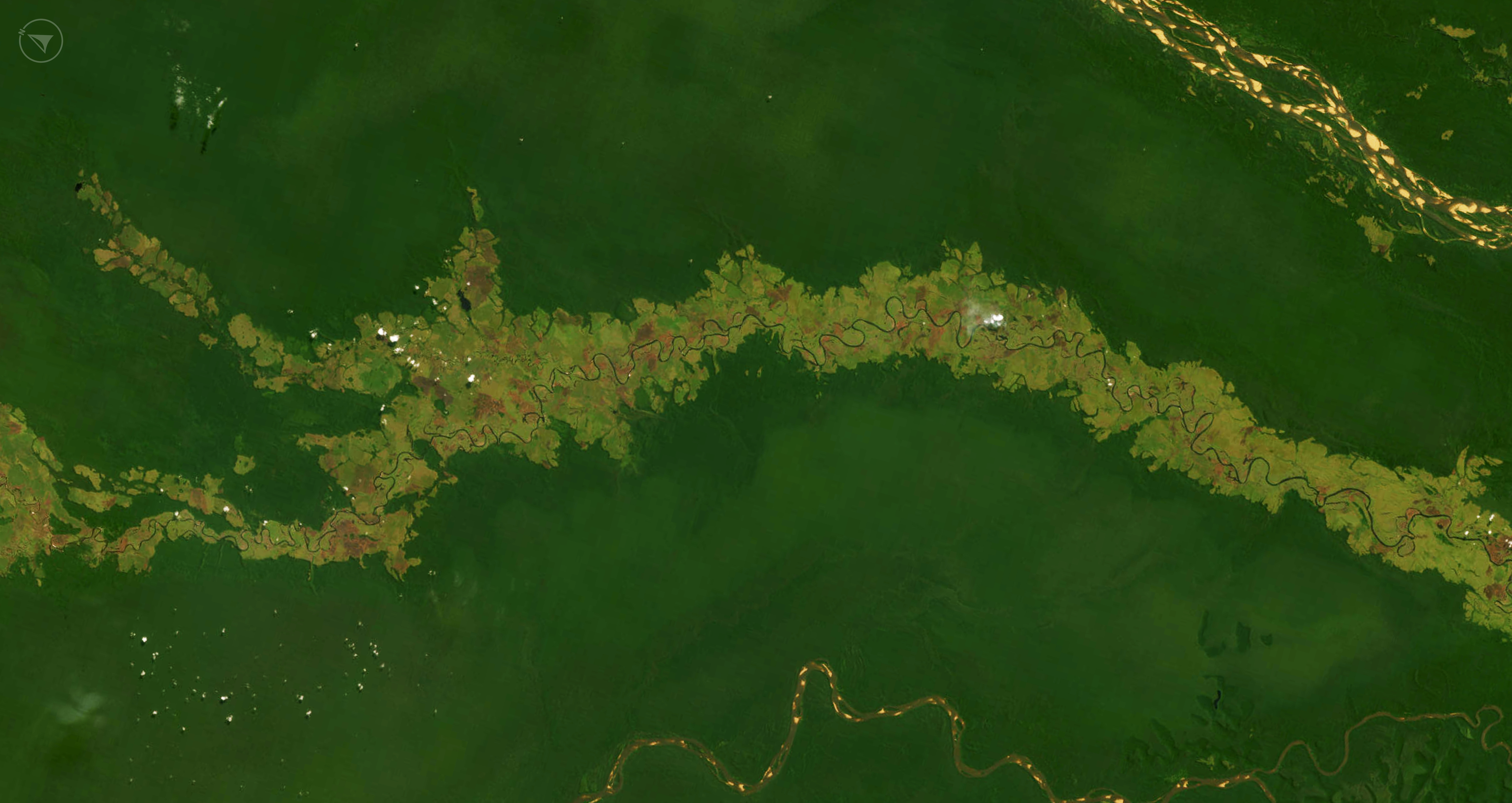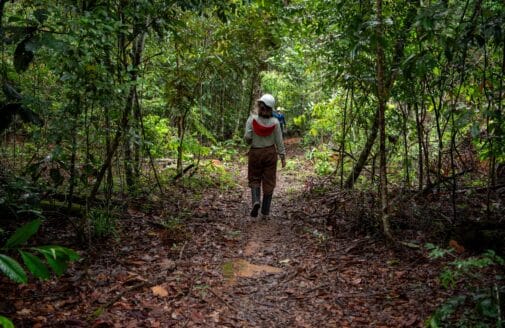Valuing the DRC’s Peatlands
Beneath the Congo rainforest, a carbon treasure trove awaits. Protecting it will require a thriving and sustainable economy.
A peatland-rich tributary of the Congo River, west of Mbandaka, DRC.
image courtesy of Maxar.com
Lire en français ici.
On the southern bank of a turbulent, muddy-brown bend in the Congo River, sits the Congolese capital of Kinshasa. Here, Woodwell Climate Associate Scientist, Dr. Glenn Bush and Forests and Climate Change Coordinator, Joseph Zambo, have joined other researchers and government officials in the conference rooms of a downtown hotel for a three-day workshop about peat.
Bush is an economist and social scientist who has worked in the Democratic Republic of Congo (DRC) for 16 years, studying the social and economic structures that shape land use. Zambo leads Woodwell Climate’s work from the DRC side, liaising between local residents, the national government, and international researchers. The pair of them are hard at work advising on the creation of the DRC’s Nationally Determined Contribution (NDC), which outlines the country’s commitment to emissions reductions within the UN climate change framework.
Peatlands, a type of wetland, could be a critical element in the DRC’s contributions. Underlying large swaths of the Congo Rainforest, these carbon-packed soils are critical to protect. But disturbances like agriculture, deforestation, and climate change have already begun nibbling at the valuable stock of carbon. And once it is released, it takes millennia to replace.
What is a peatland?
Congo peatlands are found primarily in the wet, marshy forests of the country’s “Cuvette Central” or Central Basin. They form on the water-soaked banks of stream channels—an oxygen-poor environment that slows the decomposition process, allowing organic matter to build up over time into a spongy soil that locks away carbon, preventing it from re-joining the atmosphere.

Peatlands form at the edges of river channels, an area often valuable for human uses.
photo by Nolan Kitts
A stable peatland relies on wetness. Draining a peat swamp immediately exposes that carbon to decomposition and erosion when it touches air.
“As soon as aerobic bacteria start getting in there,” says Bush. “Then all that carbon starts to become unstable. So the idea is, we just need to not disturb that peat as much as possible.”
But avoiding disturbance is a difficult thing to do these days. As populations grow, people are pushing further into forested marshland margins, often modifying them for agricultural uses like wetland rice production or fish farming to support their families and communities.
Peatlands are also extremely sensitive to degradation and deforestation across the rainforest biome. In the Congo Basin, the rainforest is actually responsible for creating most of its own rain—the spring rainy season is triggered by moisture breathed into the atmosphere by plants, rather than blown inland from the sea. This makes the Congo even more sensitive than the Amazon when it comes to the drying effects of deforestation.
“For every hectare of forest you lose in Africa, you lose proportionately more rainfall than you do for a similar amount of forest loss in Latin America or in South and Southeast Asia,” says Woodwell Climate Tropics Program Director, Dr. Mike Coe.
Deforestation in the Congo Rainforest.
photo by Glenn Bush
What we don’t know about the Congo’s peatlands
So exactly how much peatland does the Congo Basin hold? And how bad would it be in terms of emissions to lose them? The answer to both is “we don’t know for certain.”
Research has only just begun to give size and shape to this critical ecosystem. Recently, a collaborative Congolese and British team led by Dr. Simon Lewis of the University of Leeds walked two 20-30 kilometer transects of marshy forest, taking core samples to assess the existence of peatland. They found it everywhere beneath the forest. All told, an estimated 145,000 square kilometers across the entire region.

map by Christina Shintani
That translates to an estimated 30 billion metric tons of carbon—more than 20 times the United States’ annual fossil fuel emissions.
“It’s only two transects in the whole of the Congo Basin, but using that, we’ve been able to recalibrate existing models of peatland extent and quality, and it basically shows we’re sitting on a tropical carbon treasure trove,” says Bush.
Peatland protection is poverty alleviation
So protecting peatlands is important, but in practice, it’s a hard thing to accomplish. Why?
Right now, peatlands are more valuable to the people of DRC as a land resource to produce food, hunt, fish and harvest plants and materials for building, than as untouched forest. Some estimates indicate more than 90% of deforestation in the country occurs to support subsistence agriculture. It’s a necessity for the nearly three quarters of the country’s population that lives on less than $2.15 a day.
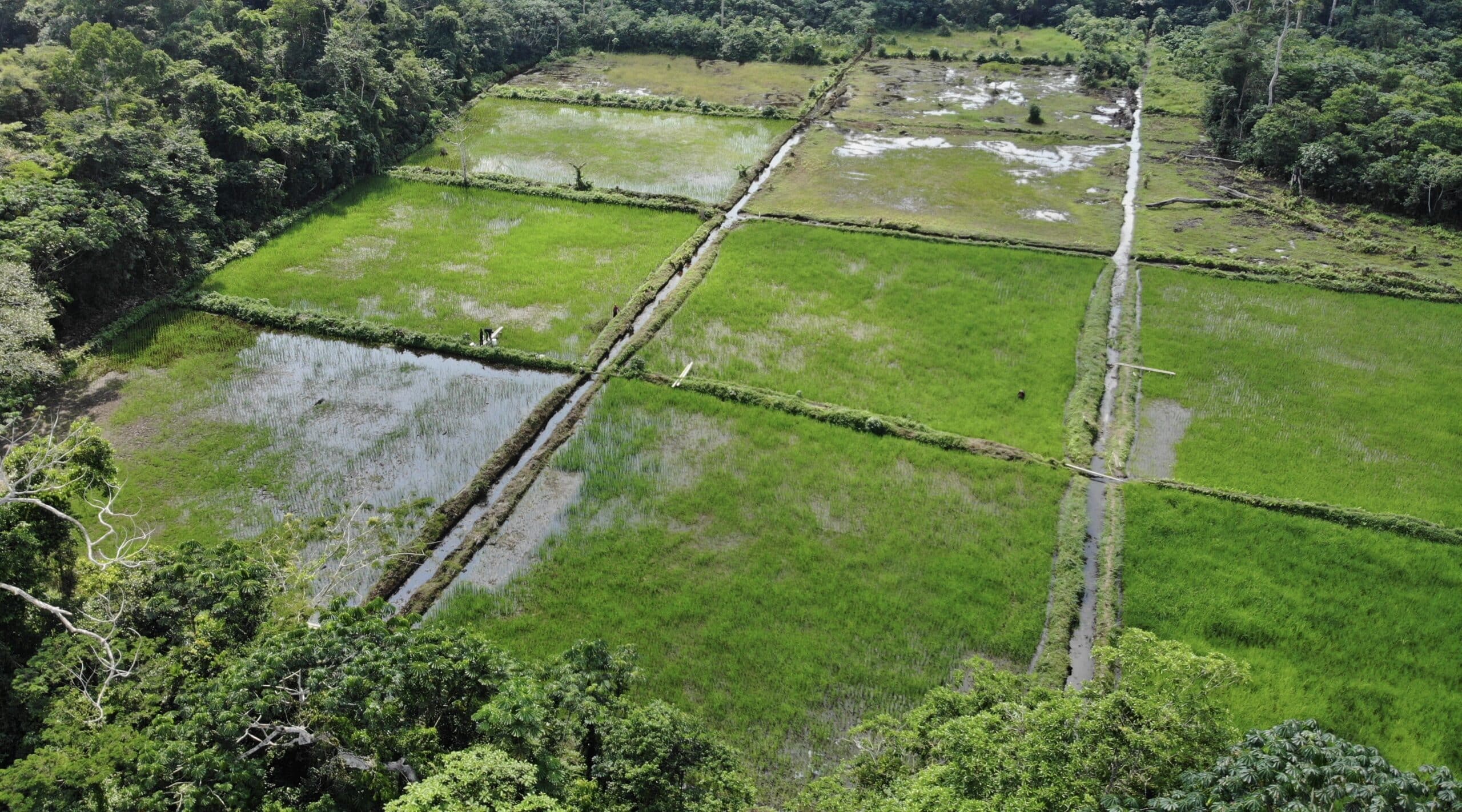
Peatlands are often converted to agricultural wetlands to grow crops like Rice.
photo by Matti Barthel and Joseph Zambo
In 2020, Zambo and Bush, alongside Woodwell Senior Research Scientist Kathleen Savage, conducted research into methods of agricultural intensification in rice paddy wetlands which are often created on deforested peatland. Applying different farming methods, involving weeding and tending to rice plants throughout the full season rather than traveling and returning for the harvest, significantly boosted yields over the same area, meaning less pressure to expand into the forest to increase productivity.
“Just by tending the rice, you could perhaps save about 30% of the forest,” says Savage.

Glenn Bush and Joseph Zambo conduct community surveys about attitudes towards sustainable agricultural practices.
photo by Nolan Kitts
Farmers recognized the benefit of this method, but were hesitant to adopt it. That time spent not tending to rice is often spent working to earn extra cash to pay immediate expenses. Waiting for a larger payout at the end of the season is not always a risk they are able to take. A good crop is not guaranteed; pests, drought, or floods could all wipe out a year’s worth of work, leaving farmers with no income. That uncertainty pushes people to make tough decisions about how to use forests.
“There’s no social safety net,” says Savage. “Well actually, the social safety net is the forest—hunting, chopping a tree down and selling the lumber because it’s worth a lot of money.”
A barge floats cut tree trunks down the Congo River.
photo by Nolan Kitts
Carbon markets could direct money to forest communities
To prevent deforestation and degradation of peatland, rural communities will need an alternative source of income. Bush and Zambo have been discussing the potential for carbon markets to supply that income.
Carbon markets are a finance mechanism that places a monetary value on preventing carbon from entering the atmosphere—or actively removing it. They function on the sale of “carbon credits” which theoretically represent one metric ton of carbon kept stored or sequestered through land management practices. Ideally, money from their purchase goes directly to the people managing the land—whether that’s a farmer protecting forests or a community group restoring degraded areas.
In reality, however, carbon credits have been challenging to verify because of weak regulations and lack of data.
“The problem with the carbon credit is nobody’s really sure about quality and standards for delivery or how to measure and monitor them because, obviously, somebody doesn’t turn up on your doorstep with a bag full of carbon,” says Bush.
So far, market implementation has been plagued by accusations of greenwashing for polluting corporations who buy offsets and government regulatory programs unable to prove positive climate and biodiversity impacts. But Bush and Zambo see potential for a version of this solution to bring more wealth directly into farmers’ hands if done right.

Zambo speaks to Congolese journalists about the DRC’s New Climate Economy at COP28 in Dubai.
photo by Heather Goldstone
Bush is working with the Carbon team at Woodwell Climate on the development of a Landscape Capital Index (LCI) that uses scientific standards to assess the potential of any tract of land to deliver climate mitigation and other benefits like biodiversity and water cycling. Once refined, the Index will provide data against which carbon credits can be checked.
Zambo has been deeply involved in conversations with the Ministry of Environment around the country’s National Net Zero Plan. Both he and Bush hope that a science-backed carbon market could make many of the sustainable development projects outlined in the plan economically feasible.
“The validation of carbon stored in this ecosystem could generate a lot of money in the country for development,” says Zambo.
Building Congolese Capacity
Another obstacle to implementing an effective carbon market is finding available data to feed the LCI. As Bush mentioned, current information on peatland carbon is based on only a thin slice of the entire watershed. In order to provide payments for local-level conservation projects, we need a much more granular understanding of the extent and quality of carbon across the entire ecosystem. Collecting that kind of data will require more scientists—Congolese scientists—and more technical capacity among officials who could be responsible for managing conservation programs in the future.
“DRC needs capacity building in the mapping of peatland areas to develop a national strategy specific to peatlands,” says Zambo.
Capacity building was a large part of the workshop in Bush and Zambo attended in Kinshasa.
“This workshop was very important in the context of sharing knowledge and advances in data collection about peatlands, in order to enable the Congolese government to identify missing data, raise awareness among stakeholders, and create synergies between peatlands and other climate initiatives,” says Zambo.
Additional technological resources could also help bolster scientific capacity. Savage has been working with Research Assistant Zoë Dietrich to develop inexpensive, portable, methane monitoring chambers for use at field research sites in Brazil and Alaska. Savage sees the potential to adapt the chamber design for use in the DRC monitoring carbon fluxes in wetland forests.

A prototype of a floating chamber that autonomously samples methane fluxes.
photo by Zoë Dietrich
“Right now, in terms of carbon accounting, [the DRC] is using measurements estimated from another similar country and the assumption is that’s what their forests are doing, too. But in order to get accurate numbers, they really need to move to direct measurements,” says Savage.
DRC’s sustainable future
There is much work to be done to build carbon markets into a viable funding mechanism for large conservation efforts in the DRC. Sustainability and economic growth will ultimately come down to providing rural households with pragmatic livelihood alternatives, and developing a sense of financial security. But Bush hopes the excitement around their potential could help push forward difficult conversations, not just around conservation and climate, but about economic governance within the country on a larger scale.
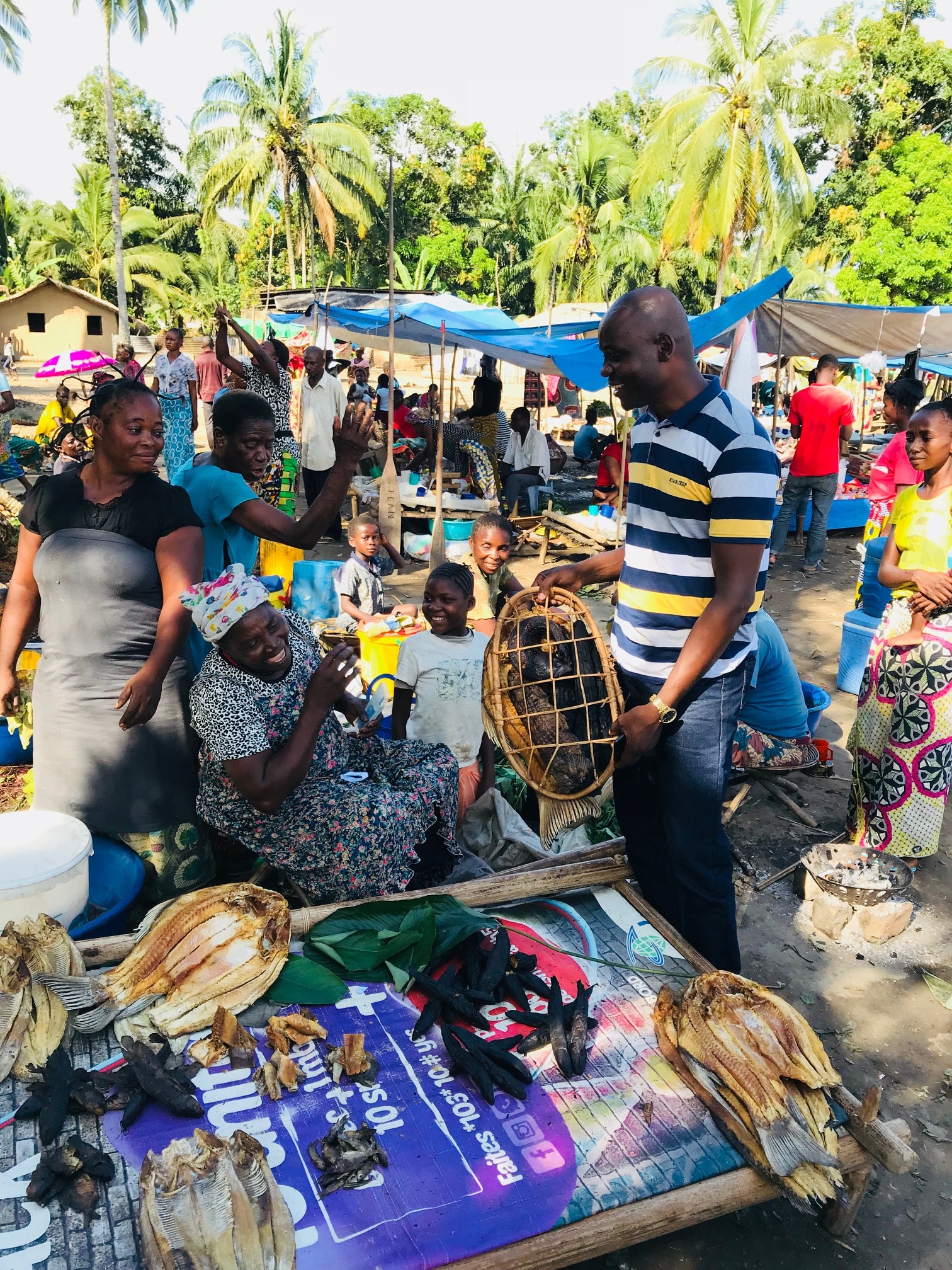
Zambo speaks with sellers at a local market.
photo by Nolan Kitts
The carbon market, after all, is a market just like the ones selling sacks of rice or valuable timber.
“Once the buyers and sellers understand the basic value of what is being bought and sold, then it requires the same framework conditions to operate as any market needs,” says Bush. “Good governance, transparency and adherence to the rule of law.”
Zambo sees a path forward as well. One where valuing peatlands for their ecosystem benefits can help lift up all of DRC.
“I hope that the conservation, protection, management, and development of peatlands and forests in the DRC can be a key driver for the country’s sustainable development,” says Zambo.





